HOPE not hate uses cookies to collect information and give you a more personalised experience on our site. You can find more information in our privacy policy. To agree to this, please click accept.

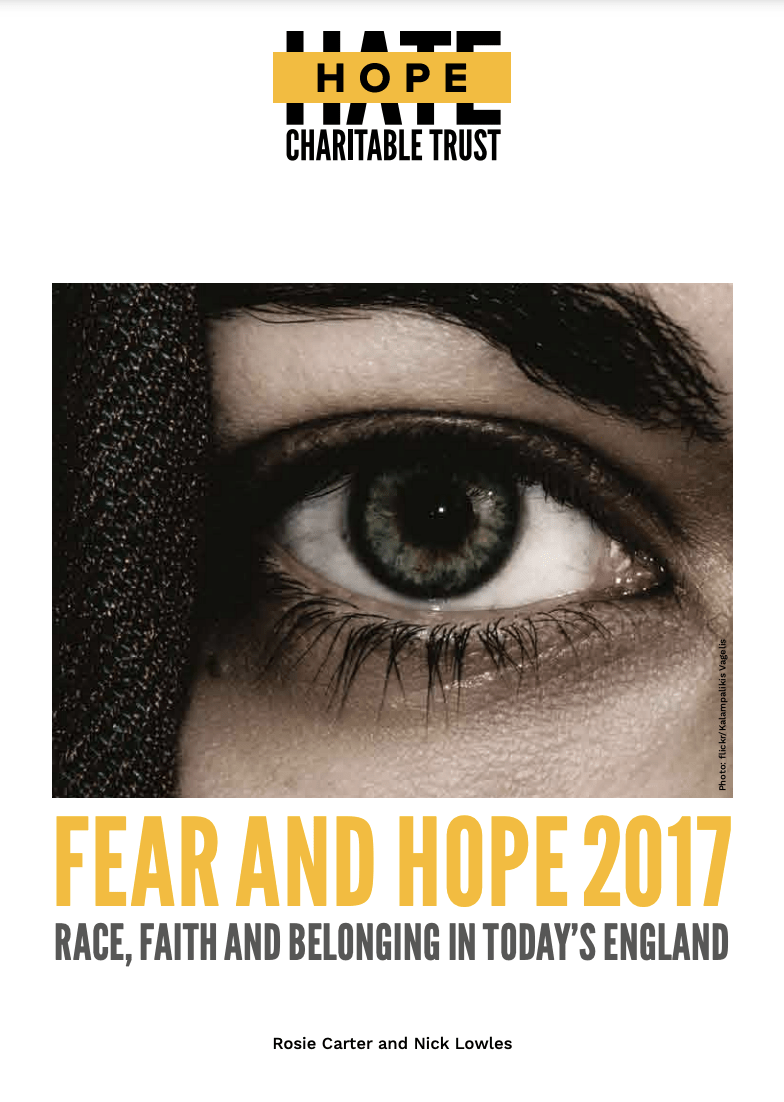
Download the full report or read selected chapters below.
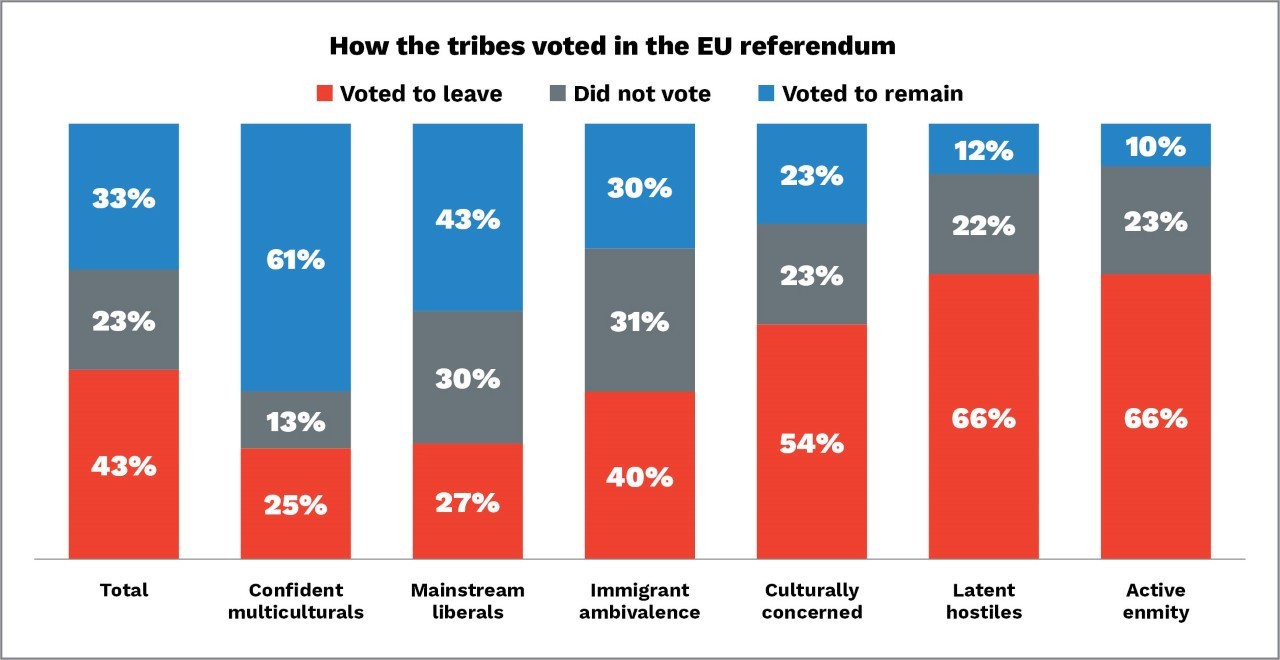
Confident Multiculturals
(22% in 2017, 22% in July 2016, 18% in February 2016, 8% in 2011)
Most likely to be graduates or post graduates, these people are predominantly professionals and managers. They are more prevalent in London and the South East, and among people who identify with Labour, Liberal Democrat and Green. Outgoing, social and happy with their lives, they are confident about their own, as well as their country’s future, and think Britain has benefitted from immigration.
The smallest group in 2011, confident multiculturals are now the largest segment, making up 22% of the population. The group more than doubled in size between 2011 and February 2016 as economic recovery offered a greater sense of security and confidence, and saw further growth following the EU referendum. This group were most likely to vote to remain in the EU (61%).
Mainstream Liberals
(17% in 2017, 16% in July 2016, 14% in February 2016, 16% in 2011)
These people are optimistic, self-motivated and for the most part educated to at least degree level. They see immigration as a net benefit to the country, and usually differ from confident multiculturals only in their level of enthusiasm about it. More likely to have voted remain in the referendum (43%), this group has remained roughly the same size since 2011.
Identity Ambivalents
(21% in 2017, 26% in July 2016, 20% in February 2016, 28% in 2011)
These people are less financially secure and less optimistic about the future. They are more likely to be working class, to live in social housing and to view immigration through the prism of its economic impact on their opportunities and the social impact on their communities.
Muslims and other BME (Black and Minority Ethnic) groups are more prevalent here and most identifying with the tribe are of working age, between 25-44. This tribe are more likely to have voted leave in the EU referendum (40%) but also host the greatest share of those who did not vote in the referendum (31%).
Since 2011 the proportion of those in the identity ambivalents tribe has decreased to around the same levels as in February 2016, as economic recovery after the 2008 crash has eased concerns held by this economically sensitive group.
There was a spike in the proportion of people in this category directly after the EU referendum, which may be reflective of the focus on economic arguments tied to immigration throughout the referendum campaigns, although this change appears to have subsided over the last year.
Culturally Concerned
(18% in 2017, 16% in July 2016, 24% in February 2016, 24% in 2011)
Generally older – 27% of the over-65s identify with this tribe. Many are (or have been) professionals and managers but the social class make up of this group has changed since 2011 to include a greater proportion from C2DE classes.
They are more likely to view immigration as a cultural issue, with concerns about the impact of immigration on national identity and about immigrants’ willingness to integrate. This group forms the largest segment of those identifying with the Conservative Party and are most likely to have voted leave in the 2016 referendum (54%).
The culturally concerned group held a constant share of the population between 2011 and February 2016, but saw a decrease of 8% just after the referendum.
Latent Hostiles
(17% in 2017, 13% in July 2016, 16% in February 2016, 10% in 2011)
More likely to be over-35, not university-educated, and more than likely working class. They view their own future with uncertainty and Britain’s future with pessimism.
For them, immigration has undermined British culture, public services and their own economic prospects. They would support political forces that stood up for their identity and way of life, but are less confrontational than those in active enmity segment. This group were most likely to vote leave in the EU referendum and are more likely to be economically pessimistic and fear the impacts of immigration on British culture.
The latent hostile group has increased from 10% in 2011 to 17% in 2017, as the active enmity tribe has shrunk. This would indicate that there remains a persistent section of the population aligned with a hostile set of identity politics – however they have become less hard-line over time.
This group is most likely to identify with UKIP.
Active Enmity
(5% in 2017, 7% in July 2016, 8% in February 2016, 13% in 2011)
Drawing more support from the unskilled and the unemployed, these people are the most disengaged from traditional political processes and the most hostile to immigrants and what they think immigration represents. They were most likely to vote leave in the EU referendum,
Opposed to all ethnicities or religions other than their own, many believe that violence is acceptable if it is a consequence of standing up for what is ‘right’.
This group has declined sharply since 2011, now making up just 5% of the population. This encouraging development indicates that even those with the deepest concerns about identity and immigration are now more likely to engage with the political system, and less likely to consider direct action or violence as a means to express their concerns.
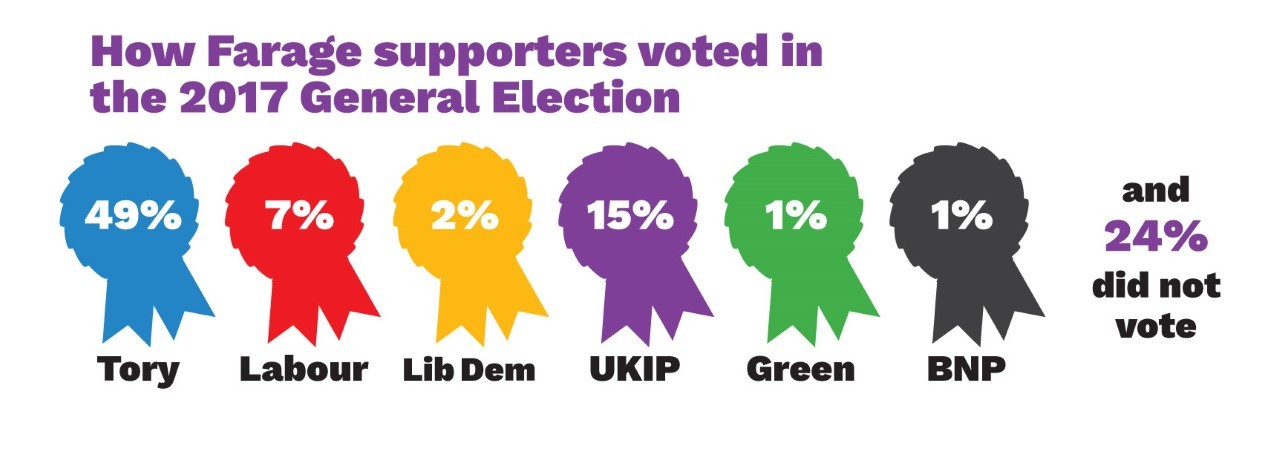
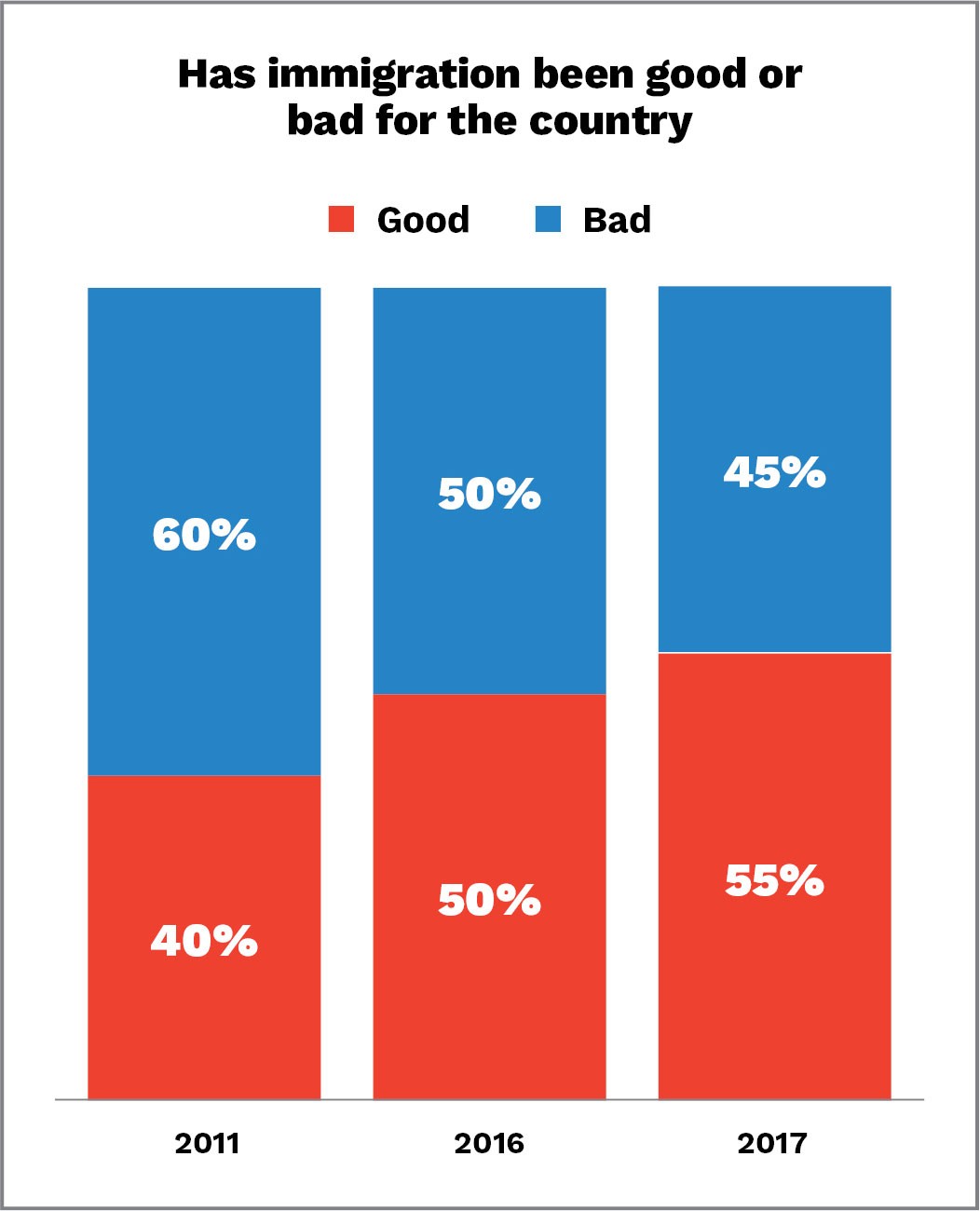
Since we first carried out our Fear and HOPE survey in 2011, a lot has happened. Changing social and economic conditions and key events over the last seven years have all influenced the way we identify and see others around us.
Here’s some of the most important ways attitudes in England have changed:
1. We’ve become a more liberal society
The proportion of the population in our two most liberal groups – which both have very liberal outlooks – has grown from 22% in 2011 to 39% today, drawing people in from the ‘middle ground’ groups. The liberal tribes have become more mixed since 2011 – now around a third are working in manual jobs and the service industry. However, the proportion of people identifying with the two hostile ‘tribes’ has remained stable and their views have not moderated since 2011.
2. We’ve cautiously felt the impacts of economic recovery
In 2011, the effects of the economic crisis and the onset of austerity cuts were clearly felt and more than half of respondents felt that things had worsened for them over the last ten years, while over 80% felt that things had worsened for Britain as a whole. By February 2016, 62% of people felt things were better in their own lives and 40% thought that things in Britain as a whole had improved. In 2017, the trends look set to have continued, as overall 37% of people feel that things are better for Britain as a whole and 61% of people feel that things are better in their own lives.
The results of the EU referendum had a clear impact on how people feel about the future, and show just how divisive the referendum result and Brexit process could be. Immediately after the EU referendum, it was clear that some felt change was in the air, and the more hostile tribes became far more optimistic. For others, the shock of the result felt like an earthquake that unsettled their outlook on life, shown by the decline in optimism among the more liberal tribes.
3. Fewer people identify with being English than they did in 2011
In 2011, 39% of people identified as English and 50% of people identified as British. In 2017, 34% of people identified as English and 54% saw themselves as British. Just 11% of Black and Minority Ethnic (BAME) identify themselves as English. Across England, national identity is seen as far more important than religion, ethnicity, the country you live in, or any local identity with a city, town, village or local community. The more hostile tribes are more likely to select factors such as “parent born here” or “celebrate British holidays” as the most important to be considered British, reflecting their anti-immigrant views.
4. Support for English nationalists has steadily decreased since 2011
In 2011, 67% of the active enmity tribe and 57% of the latent hostiles group stated that in response to a clash between Islamic extremists and English nationalist extremists, their sympathies lay with English nationalist groups, a pattern which has fallen to 52% and 49% respectively in 2017. The vast majority of people (74%) reject the activities of both Islamic extremists and English nationalists who are considered as bad as each other. In response to a proposed new mosque, 13% fewer people would support a campaign to stop the mosque than in 2011, and 10% more would actively oppose a campaign to stop the mosque. This issue is less divisive than in 2011.
5. We are more likely to see the positives of immigration
More people now (55%) think that immigration has been good for Britain, up from 40% in 2011. Those wanting to stop all immigration permanently are in the minority at just 12%, down from 18% in 2011.
However, there are some clear concerns about immigration: 75% of people think that immigration adds to pressure on public services and 21% of people think that immigration has made it harder to get a decent wage for the work they do. However, we are more likely to meet a consensus as the liberal and hostile tribes are more likely to agree on the things that trouble us than in 2011.
6. The Conservatives have drawn a more working class voter base, while Labour’s support is becoming more liberal, educated and tolerant.
The makeup of the culturally concerned group – which forms the core of the Conservative’s voter base – has changed substantially from 32% C2, DE in 2011 to 50% in 2017. And the party has drawn in a new set of voters: 49% of people who voted for UKIP in 2015 put their trust in the Conservatives in 2017.In 2011, 30% of those supporting Labour came from our two most liberal tribes. Today, this figure has risen to 52%.
As Labour’s support is drawn from more liberal sections of society, so this influences its policies and outlook, pushing the party to even more liberal positions. However, this naturally comes into conflict with the views of its more socially conservative working class supporters and – fundamentally now that Labour has a chance of winning the next election – voters in the seats it needs to win to form a majority.
UKIP’s base has remained relatively constant since 2011, still drawing almost two thirds of its supporter base from the hostile ‘tribes’. It has regained support from the immigrant ambivalent group since 2016.
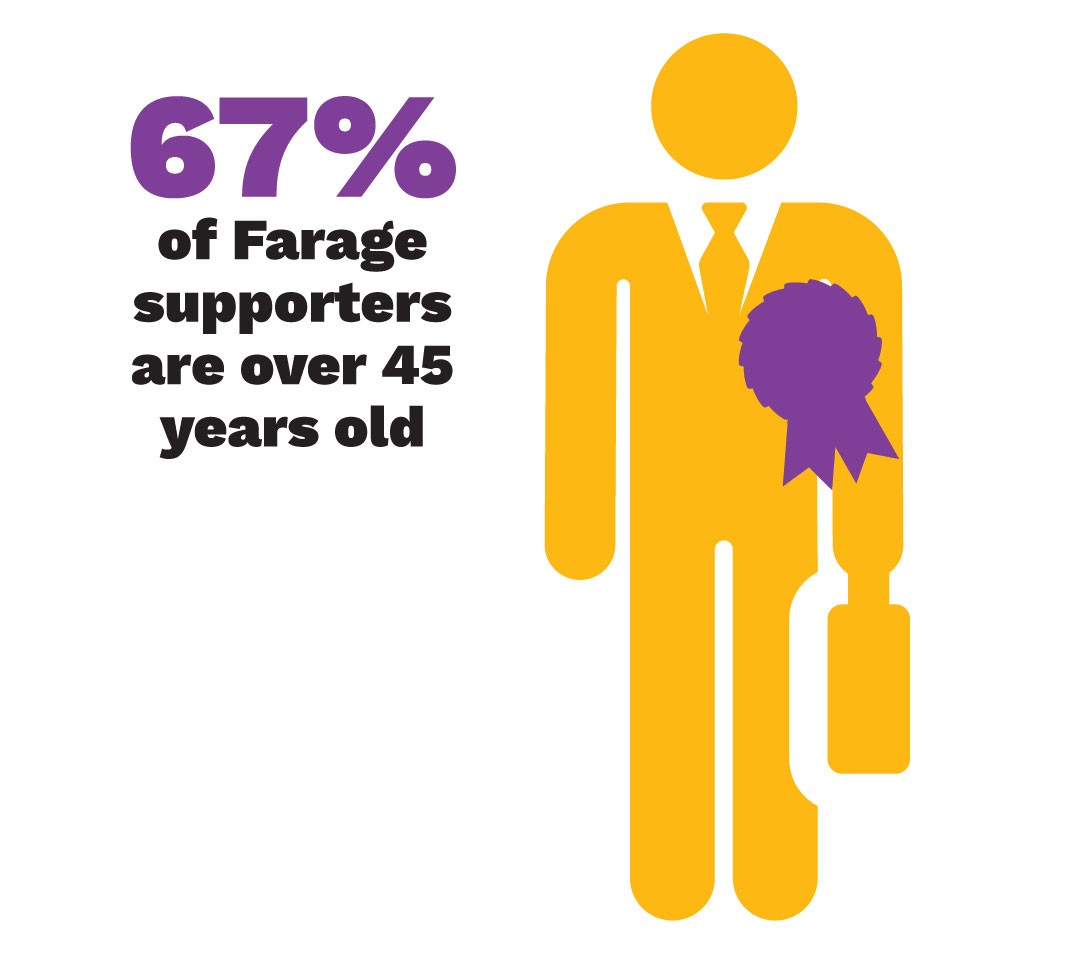
The Fear and HOPE survey reveals that 14% of English people identified most with Nigel Farage as the politician with the views closest to theirs.
This is a remarkable figure, given that he is not currently a political leader and UKIP polled so poorly in the 2017 General Election.
It should act as a warning of potential support for the new party that Farage and millionaire (and former UKIP bankroller) Arron Banks plan to set up in the autumn.
Supporters
So what does a Farage supporter look like? And how do their views compare with the rest of the population?
Farage’s supporters are more likely to be men. They are more likely to be older, and 65% are over 45. They are more likely to be Christian than other respondents (53%) and they are most likely white – a staggering 96%.
They tend to be less educated and 74% are non-graduates. A fifth live in the South East of England, but only 7% are in London.
In the 2017 election, only 15% of these supporters actually put their faith in UKIP, with the majority lending their votes to the Conservative party, who were most trusted on Brexit. Although many had been Labour supporters in 2010 and 2015, just 7% voted for Labour. Many are unhappy with the political class, and 24% did not vote at all.
Sceptics
The Farage supporter is sceptical about immigration, and wary of social change.
Half (49%) think that immigration has changed their local community for the worse, compared to a quarter of the total population.
A huge 80% think that immigrants don’t want to integrate, compared to 49% of the general population, and they don’t see positives in multiculturalism – just 11% agree that migrants have added richness and variety to the culture of Britain and made the country more prosperous.
Islam
Their anxieties about others are particularly acute when asked about Muslims in Britain.
85% of Farage supporters believe that Muslims cause problems in the world compared to 54% of all respondents.
32% believe that it is reasonable to blame an entire religion for the actions of a few extremists and they are unlikely to think that the media is negative about Muslims or that discrimination is a problem for Muslims in Britain.
72% say that their suspicion of Muslims has increased since the recent terror attacks and 77% agree that the burqa should be banned.
Nationalists, Brexit
Worryingly, in response to reports of violence between English nationalist extremists and Muslim extremists, more Farage supporters side with English nationalists than condemn both groups.
65% would support a campaign to stop mosques being built and 38% believe violence would be acceptable in this campaign.
Their support for Brexit is loud and clear, and they are optimistic about Britain’s future outside of the EU.
69% think the country will benefit from reduced immigration, compared to just 36% of all English people and 60% of Farage supporters would respond with anger if Britain was to compromise on ending free movement.
62% feel that the country’s economic circumstances will improve, compared to just a quarter of all respondents.
Despite Nigel’s downfall, the Farage supporter remains defiantly hostile.
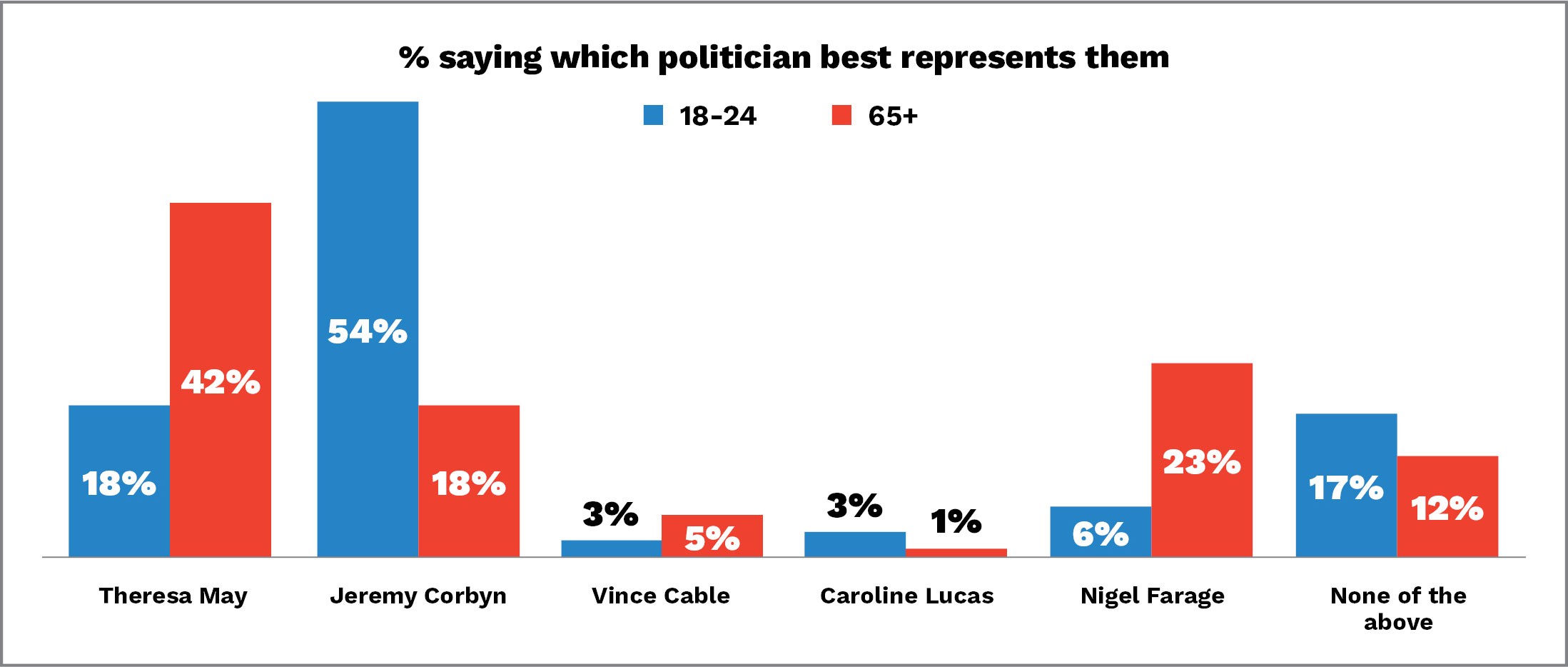
Since 2011, there have been several shifts in the way the identity ‘tribes’ place their political trust.
Conservatives
The support base for the Conservatives has changed quite considerably since 2011. The party continues to source its ground support from the culturally concerned group, but this share has fallen over time, from 42% in 2011 to 28% in 2017.
The party has increased its share of votes from the two more liberal tribes by a huge 23% over the last six years. It may continue to draw votes from the two more hostile tribes, but it is clear that heading towards a hard Brexit with a strong anti-immigration and anti-multiculturalism stance may alienate a large proportion of its voters.
UKIP and the Challenge for Labour
Since we began our Fear and HOPE research in 2011, we have seen the rise and fall of UKIP and, simultaneously, the decline and resurgence of a very different Labour party.
The collapse of UKIP has left behind a key political target large enough to determine an election, particularly in Labour’s traditional heartlands. Typically swing voters driven by economic insecurity, Farage’s party had tapped into a sense, particularly in the North, that Labour was no longer representative of working class communities but part of the establishment, metropolitan and London-centric.
With UKIP falling apart in the snap election, many saw Labour’s success as a sign that the party had recaptured those who strayed towards UKIP in 2015. However, our Fear and HOPE survey has found that just 7% of this group turned to Labour in 2017.
While 15% of people who voted UKIP in 2015 stayed with the party in 2017, half (49%) unenthusiastically defected to the Conservatives who they saw as the ‘Brexit party’, and 24% did not vote at all.
Corbyn’s socialist campaign failed to chime with disenfranchised working class voters, instead increasing Labour’s share of liberal, educated voters whose views have hardened since the referendum as people disassociate themselves from “Brexit Britain”.
Our report segments society into six identity ‘tribes’: two very positive about immigration and multiculturalism and two strongly opposed, whose views have become increasingly polarised.
Of the two ‘middle ground’ tribes, one is economically secure but culturally concerned about changes in society and one – a key target for Labour, and from where much of the UKIP’s 2015 swing derives – is driven by economic insecurity.
In 2011, 30% of Labour’s support came from the two more liberal ‘tribes’. In 2017, this has risen to 52%.
Looking at the values of Corbyn supporters against the 2015 UKIP voter, the differences are stark.
While many 2015 UKIP voters would have economically and socially benefited from a Corbyn-led government, on political and cultural issues the two sets of supporters were miles apart.
Where Corbyn supporters are open and tolerant, 2015 UKIP voters were hostile towards immigration, sceptical of multiculturalism and fearful of Muslims. The Corbyn supporter focuses most on the poor state of the public of the public services and increasing government intervention, while the 2015 UKIP voter resented money going to groups they believed were undeserving and wanted a stronger state and harsher penalties for criminals.
Brexit
Further, Brexit has polarised the nation and our poll finds little room for common ground. Any compromise on a deal is likely to increase resentment and feelings of political betrayal. Impending economic downturn as we leave the EU is likely to trigger fear and hostility towards others among the economically insecure and could widen this gap.
It would seem an impossible circle to square for Labour, to hold on to its growing liberal, educated and tolerant base while appealing to its traditional, more socially conservative, working class supporters. But this is a key challenge to be addressed if Labour is to win a parliamentary majority again, now that it has a chance of winning the next election.
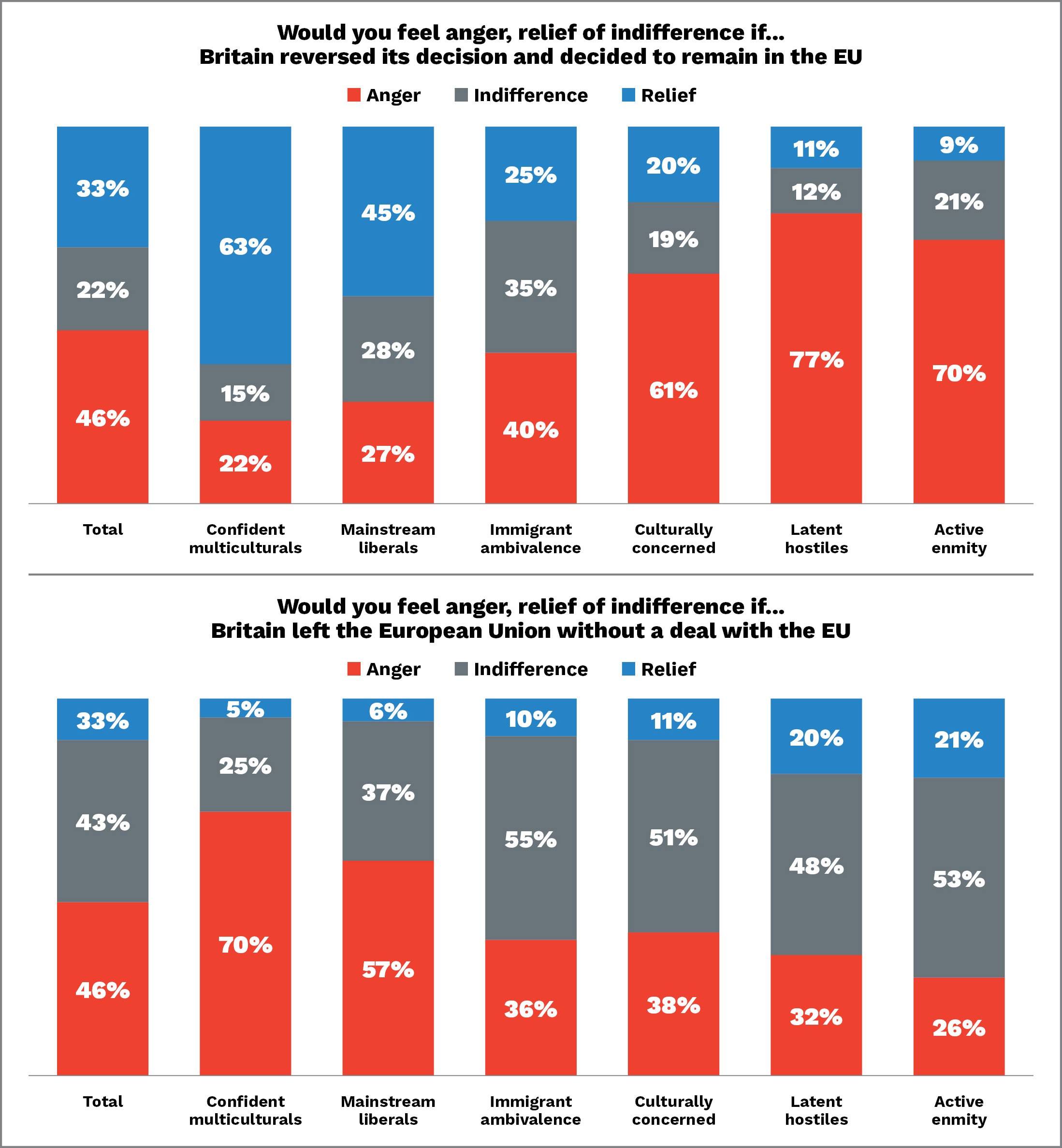
Politics over the next few years will be dominated by Britain’s decision to leave the European Union. Just after the referendum, 63% of Fear and HOPE respondents believed Britain was more divided as a result of the vote and the numbers of people who believe there are tensions between different communities at a local and national level had increased: just 12% of people disagreed.
As our 2017 survey shows, the country is just as divided a year on and there appears little room for compromise or a solution that will please everyone.
Frustrations on both sides
As our post-referendum Fear and HOPE highlighted, what a ‘good deal’ might mean is very different to different groups. When leave voters were asked the most important factors in their voting decision, 58% of the active enmity group and 44% of the latent hostile group felt that regaining control over borders and immigration was the most important factor. For remain voters across all tribes, economic risks and access to the single market were more significant.
Now that Brexit negotiations have begun, we presented survey participants with a number of possible outcomes. Indeed, there are a lot of frustrations on both sides. It is more likely that the eventual deal will disappoint virtually everyone, and only 6% of people have a great deal of confidence that Theresa May will secure a good deal for Britain.
The hostile tribes are angry about a situation that would relieve liberal remainers, while these liberal tribes would be equally angry at a situation that relieved the more hostile groups. 51% of confident multiculturals would be enraged by a deal in which Britain withdrew from the single market in order to limit immigration while the exact same proportion of latent hostiles would be angered were the UK to remain in the single market but retain free movement. 77% of latent hostiles and 70% of the active enmity group would feel anger if Britain were to repeal the result of the referendum and remain in the EU, while this would relieve around the same proportion of confident multiculturals (63%).
The only scenario which had a clear majority one way or another was if Britain left the EU without a deal. Only 11% of people displayed relief at that scenario, whilst 46% reacted with anger.
Lessons for Remainers
Despite the clear polarisation within society over leaving the EU, there is little to cheer strong Remainers. There is little appetite for a second referendum and no indication that the result would be any different if there was a second vote. The uncertainty about what Brexit will mean for the country has created a sense of unease and frustration among those most likely to have voted remain, whose views are looking increasingly separated from the popular majority.
What is clear is that a year on from the referendum, the Remainers have still not made an effective and persuasive case for the economic perils of leaving the EU that resonates with the British public. Unless they can create a new narrative quickly, it would seem that the Remainers will have to wait for the impact of Brexit to actually be felt before hoping to win over the soft Brexit vote – and by which time it would be too late to do anything about it.
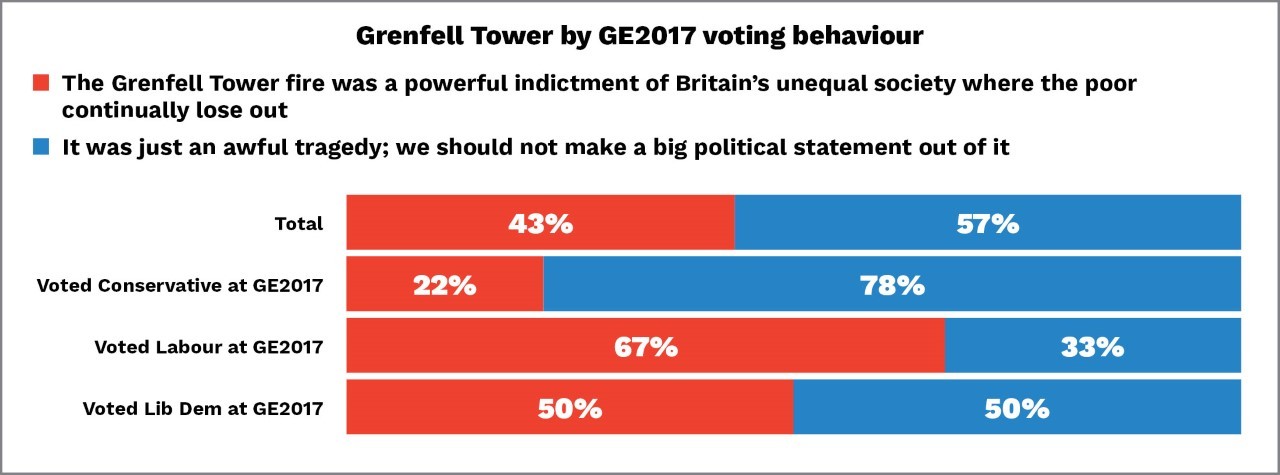
Fear and HOPE 2017 finds that attitudes in London are distinct from the rest of the country. On the whole, Londoners are open and tolerant towards others and have shown strong resilience to tragic recent events in the city.
Migration and multiculturalism
London is a city of migration and hosts the greatest number of migrants anywhere in the UK – an estimated 3.2 million foreign-born people call London home.
The diversity of the city welcomes newcomers, with Londoners are 17% more likely than those elsewhere in England to believe there is a place for everyone in Britain.
Our poll estimates that people in London see this as a positive thing – they are 15% more likely to see immigration as a good thing for the country versus those outside of the capital, and are far more likely to think that cultural diversity benefits British culture (71% of Londoners agree compared to just 51% of those elsewhere).
Recent terror attacks
Despite the tragic events this summer, following the attacks on Westminster, Borough Market and Finsbury Park, 80% of Londoners believe that it is wrong to blame an entire religion for the actions of a few extremists.
While the attacks have worsened attitudes towards Muslims across England since our last poll in 2011, this has been less profound in London.
31% of Londoners said that the recent terror attacks had increased their suspicion towards Muslims, compared to 41% of people outside the city.
86% of people in the city have been impressed with the unity shown by the British population in the face of terror attacks, while 64% of Londoners had noticed Muslim community leaders speaking out about the attacks compared to 52% of non-Londoners.
Grenfell Tower Fire
The Grenfell Tower disaster has deeply divided the country. Londoners, Labour voters and those from BAME backgrounds draw a wider lesson about Britain’s unequal society, while those outside London, Conservatives and Nigel Farage supporters view it as an isolated unfortunate accident.
57% of people across England felt that the fire was not something from which to make a big political statement, while 43% felt that the fire was an indictment of Britain’s unequal society where the poor continually lose out. Young people and black and minority ethnic respondents were more likely to see Grenfell as a manifestation of wider inequality.
The share of these views was considerably different inside and outside of London and the anger of many, manifest in the ‘day of rage’ protests and demonstrations around Kensington following the blaze, was carried across the city.
Within London, 58% of people thought that the fire was a sign of inequality, while outside of London 59% of people felt that the fire was not something to make a political statement from. Londoners will likely have been exposed to more press coverage of the fire, plus the proximity of the tragic event and Londoners’ own experiences with housing in the capital, will have raised awareness of the struggles of those affected.
The reaction to Grenfell was also divided along political lines. Two-thirds of those who voted Labour in the recent General Election saw Grenfell as a symbol of wider social inequality, while over three-quarters of people who voted Conservative viewed it as a one-off tragedy.
The attitude of the 14% of the population that identified with Nigel Farage took a very similar view to that of the Conservative Party. Those who identified with Jeremy Corbyn unsurprisingly hold a diametrically opposite view.
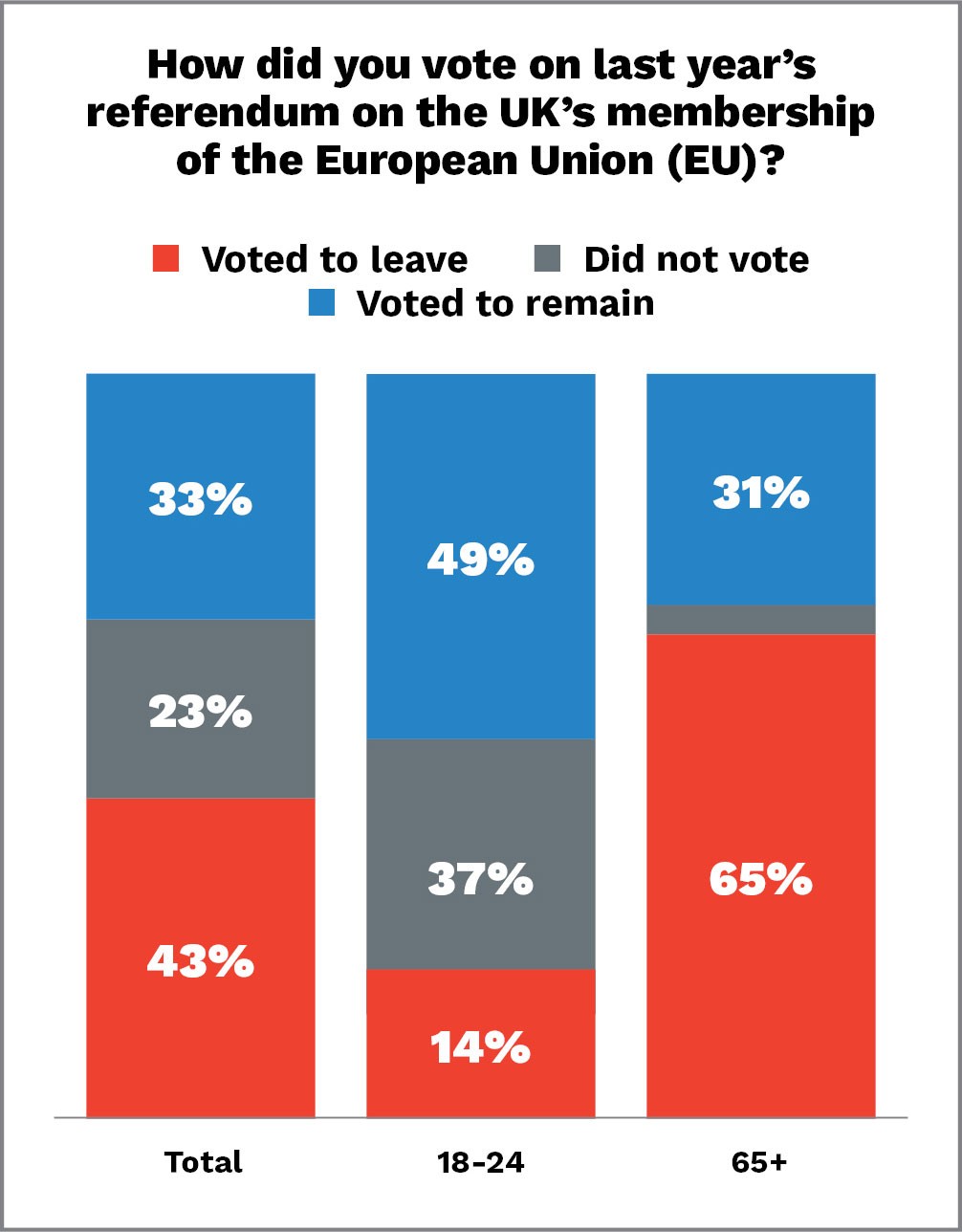
Generational differences have dominated commentary around a number of key events in recent years.
In the EU referendum, the high share of leave voters among the 65+ age set and the strong remain vote among 18-24 year olds caused fury among the younger generation.
The 2017 election has also been seen this generational divide, as the youth vote ‘got it’s own back’ on Brexit. Young people were seen to be critical in the unexpected swing towards Labour as liberal young voters surged to the ballot box.
Tribes
Looking at the share of tribes for each age group, 18-24 year olds are most likely to fit within the two liberal tribes (56%), with a small share identifying with the more hostile segments of society (17%).
Among the 65s+, the most populous group (27%) is the culturally concerned, economically secure group. Meanwhile, a staggering 54% of 18-24 year olds say that Jeremy Corbyn best represents their views, while 42% of the 65s+ identify with Theresa May.
Views
But looking at specific issues the generational divide appears to be less clear. Both the older and younger age groups feel more optimistic than pessimistic about the future than the average person.
On immigration the young are more enthusiastic – 68% feel that it has been good for the country. But the majority of both generations feel that it has had a positive impact, putting the over-65s ahead of middle-aged groups in their support for immigration. The over-65s are only 6% more likely to feel that different ethnic groups don’t get on well than 18-24 year olds.
However, the old do seem more stuck in their ways about some things. This older age set is more sceptical about multiculturalism than the average person, and shows some resistance to learning about others.
63% of over 65s believe some people are too different to fit in, compared to just 23% of 18-24 year olds.
Islamophobia, Brexit
When it comes to specific groups the differences between generations and the cultural concerns of the over-65s become more apparent, and Islamophobia appears more common among the older generation.
Conversely, 18-24 year olds are likely to feel strongly that Muslims face too much discrimination and strongly reject notions that Islam poses a threat to the West.
On Brexit, the generational splits are clear. The over-65s are optimistic about Brexit: 77% believe we can thrive outside of the single market, while only 28% of under-25s agree. Most older voters believe leaving the single market is a price to pay to end free movement into the UK, while most under-25s reject that possibility.
The younger generation evidently fears the outcomes of Brexit, while the vast majority of over-65s would feel angered if the UK reversed its decision to leave the EU.
There is room for common ground between the generations, and age divides may not be as engrained as first thought. However, Brexit is clearly a huge factor separating the young from the old which could widen the gap as negotiations begin.
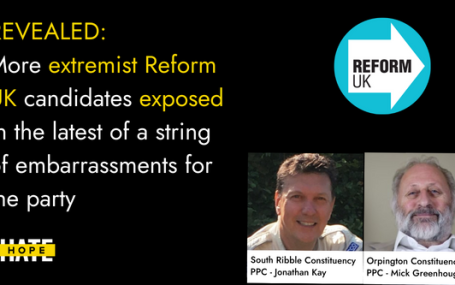
HOPE not hate reveals two more extremist candidates from Reform UK, in the latest of a string of embarrassments for the party UPDATE: Just hours…